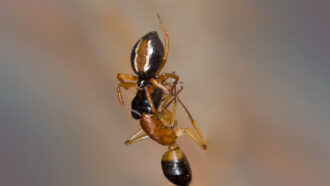
For one tiny Australian spider, somersaulting is the secret to taking on ants twice its size.
Ants — armed with powerful jaws and sometimes chemical weapons — are so dangerous to spiders that fewer than 1 percent of arachnids attempt to hunt the insects (SN: 9/8/21). High-speed footage now reveals that the Australian ant-slayer spider (Euryopis umbilicata) can tackle this risky prey by leaping over and lassoing its victims with silk.
The hunting maneuver hasn’t been found in any other spider species, researchers report September 19 in the Proceedings of the National Academy of Sciences.
“This acrobatic behavior is just fascinating. I’ve personally never seen this kind of hunting,” says Paula Cushing, an evolutionary biologist and curator of invertebrate zoology at the Denver Museum of Nature & Science, who was not involved in the study.
Alfonso Aceves-Aparicio, a behavioral ecologist at the Max Plank Institute for Chemical Ecology in Jena, Germany, stumbled across the somersaulting spiders while walking home one night. A graduate student at Macquarie University in Sydney at the time, Aceves-Aparicio was intrigued when he noticed dark dots darting across the pale bark of a eucalyptus tree.
The dots were tiny spiders moving among ants. Suddenly, one of the spiders jumped. “I thought it was trying to escape an ant,” Aceves-Aparicio recalls. “But then I saw the ant floating and I thought, woah, there’s something going on here.”
Aceves-Aparicio borrowed a high-speed camera to see what the spiders were doing in greater detail. By slowing the action down, he and his colleagues could see that the spiders were in fact hunting ants in a completely unknown way.
Most ant-hunting spiders use webs or sneak up on their prey from behind to minimize risk. But despite being smaller than their prey, Aceves-Aparicio’s spiders were facing banded sugar ants (Camponotus consobrinus) head on. Each spider positioned itself so that it could watch ants as they moved up the tree. As one approached, the spider flipped above its prey. Once in the air, the spider latched a thread of silk onto the ant.
Ant-slayer spiders capture their prey by jumping over ants and tagging them with a thread of silk (shown here in real time, then slow motion) — a leap that lasts all of a few milliseconds. The spiders then dart around ants to trap them in more silk and sweep them off their feet.
This single tethering action — performed in the space of milliseconds — determined whether the hunt would succeed. If the tether stuck, the spider then darted around the ant, deftly encircling them with more silk and yanking them off their feet to be dragged off and consumed.
What stands out to Aceves-Aparicio and his colleagues was the technique’s effectiveness. Predators like lions and wolves tend to miss around 50 percent of their intended targets. The success rate of the 60 spider hunts that the researchers filmed was a staggering 85 percent.
To Aceves-Aparicio, the discovery shows that extraordinary behaviors can hide in plain sight. “The message here is to have a little curiosity and to pay attention,” he says. “There are things going on everywhere. We just have to be there to find them.”

 A new treatment could restore some mobility in people paralyzed by strokes
A new treatment could restore some mobility in people paralyzed by strokes  What has Perseverance found in two years on Mars?
What has Perseverance found in two years on Mars?  This robot automatically tucks its limbs to squeeze through spaces
This robot automatically tucks its limbs to squeeze through spaces  Greta Thunberg’s new book urges the world to take climate action now
Greta Thunberg’s new book urges the world to take climate action now  Glassy eyes may help young crustaceans hide from predators in plain sight
Glassy eyes may help young crustaceans hide from predators in plain sight  A chemical imbalance doesn’t explain depression. So what does?
A chemical imbalance doesn’t explain depression. So what does?